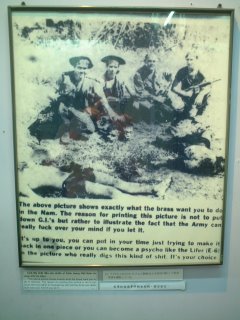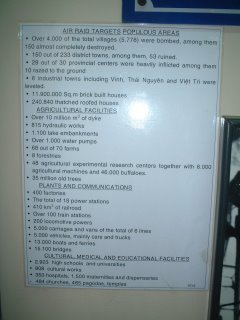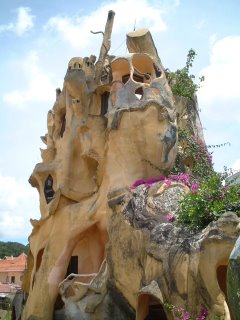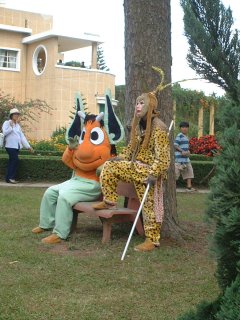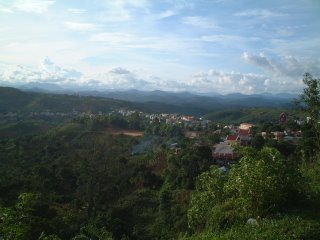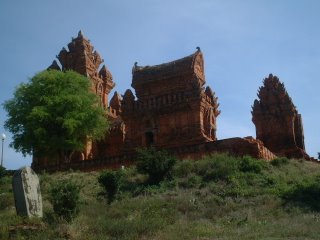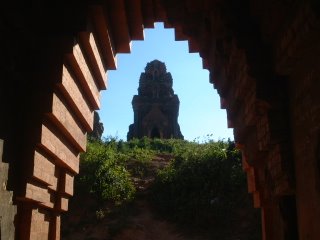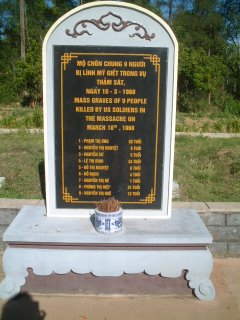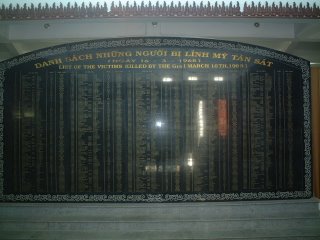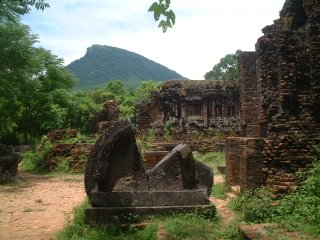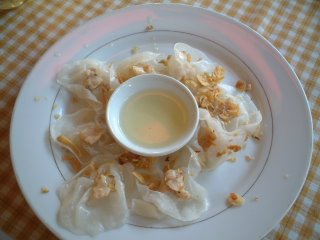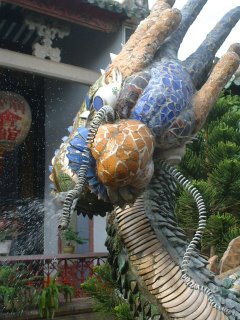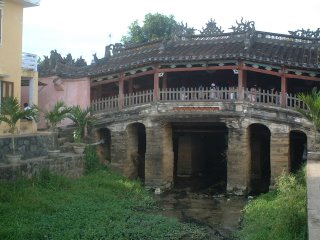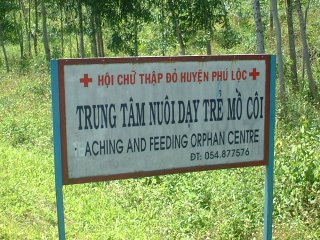And now, the end is here, it's time to face the final curtain....

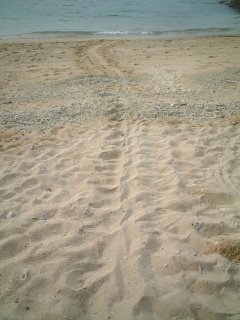


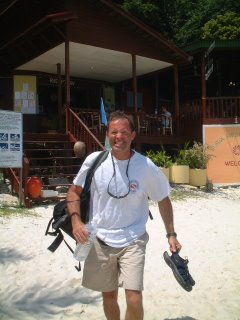
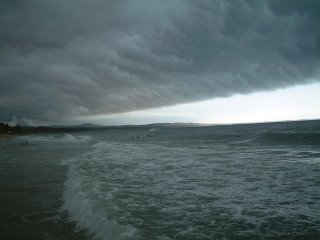
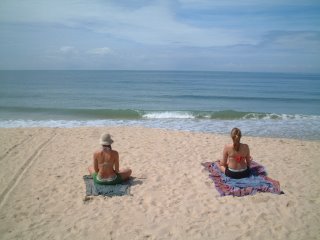

Ottawa, July 7
Here I sit at my mother's computer, back in the order, quiet and expensive surroundings of Canada's capital (and my birthplace, almost 38 years ago). contemplating the fact that my bike trip is now well and truly over. The past few weeks have been a very different experience from the rest of the bike trip, an uneventful but relaxing addendum spent mostly on beaches and in buses.
Unable to catch a plane to Phu Quoc Island, my original destination of choice for the end of the Vietnam leg, I decided to make the best of a bad job and backtrack up the coast by bus to the beach town of Mui Ne. It was a good choice. Sitting in my comfy bus seat, reading Fast Food Nation, it took only 5 hours to cover 200 km of over-developed concrete nastiness. I tumbled off the bus, found a comfortable beach bungalow and settled in for four days of serious sloth. The very fact that there were beach bungalows to be had (albeit concrete bungalows with air conditioning) was an indication of how Mui Ne was different from all of the other beach resorts I had encountered on my way down the coast, all of which were ugly, overcrowded strips of high-rises, big hotels, brothels/massage parlours, karaoke joints and loitering touts, pimps and drug dealers. Mui Ne consists of a long golden beach, washed by decent surf, backed by a single row of small hotels, many of which are little bunglalow developments aimed at backpackers. It's a great place to sit on the beach, read a few books, do some bodysurfing and watch the World Cup soccer at one of the restaurants or bars along the beach. Mui Ne is best known as a centre for kite surfing, but the prices being asked for rental and lessons would have been expensive even in Europe, so I took a miss and did lots of bodysurfing instead. I also got started on writing my second book, an account of my Silk Road ride in 2002 and 2004. I didn't get done as much writing done as I had wanted, but still it was good to unplug from the frantic noisiness of cycling along Route 1A, sleep a lot, go running along the beach and link up with German and Dutch soccer fans beside Jibes Bar's big-screen TV. It was hard to leave Mui Ne on the afternoon of the 20th and head back into Saigon. My last night in Vietnam was spent drinking bia hoi (at a new bargain price of 3500 dong, or 22 US cents, per litre) and watching Germany and England play their last World Cup group matches; I staggered back to my hotel at 4 am.
Two hours later, when my alarm went off, I deeply regretted having stayed up that late. I rode my bicycle through the remarkably orderly traffic of Saigon to the airport, located only 9 km from my hotel, well within the suburban sprawl. I took off my pedals and seat, turned the handlebars up and sideways to make the bike flatter and more compact, and half-deflated the tires before checking it in as one of my pieces of luggage for Kuala Lumpur. I arrived in KL, still groggy despite sleeping most of the flight, and realized that, since my bike wasn't allowed on the airport train, it was going to cost over $20 to take a minivan into town. Instead, I decided to have one last bike ride, covering the 70 km into the city. It was a penny-pincher's false economy, as I got caught in a colossal cloudburst which seeped into my luggage around my raincovers and soaked much of my clothing, and got hopelessly lost in the convoluted maze of KL's meandering road network. I got to the train station too late to catch the night train to Bangkok and ended up spending the night in a hostel.
The next three days were a blur of transport, as I caught buses all the way north to Bangkok (24 hours of non-stop travel; by the time I got to Bangkok, all those wet clothes in my luggage smelled really delicious in the tropical heat!), picked up some luggage which I had mailed to myself poste restante from Japan, dropped that off in a luggage storeroom at a guesthouse on Khao San Road along with my bicycle and biking gear, and caught a night bus back towards the Malaysian border, traveling with only my guitar and a small daypack as luggage. I spent the next evening in Kota Bharu, the interesting city in the northeast corner of Malaysia, eating myself silly in the wonderful night market. Finally, early in the morning, I shared a taxi to the boat jetty at Kuala Besut and caught a speedboat out to the Perhentian islands, the lovely tropical islands that are a highlight of Peninsular Malaysia.
Despite having missed my rendezvous with my friend Greg, we found each other on the beach soon after my arrival and we settled into an overpriced hotel. The Perhentians are a victim of their own popularity, with too many backpackers crowding the hotels and making for slipshod, ugly development and ridiculously overpriced accommodation and food. On the other hand, the natural beauty of the islands is impressive, and we spent the next three days snorkeling, diving and walking, inbetween bouts of chess and eating. Visibility was not what it might have been in the water, but we still saw plenty of turtles and blacktip reef sharks and a huge stingray, among other things. We went diving at Redang Island, the more expensive and more pristine neighbouring island to the south, and it was well worth the extra time and effort involved in getting there. Given the crystalline waters and untouched nature to be found on Redang, it might almost be worth spending the extra money and staying there rather than on the Perhentians.
After Greg headed back home from his lightning 50th-birthday trip, I moved to the cheapest accommodation on the islands, the isolated D'Lagoon, for my last three days. It was a great location for snorkeling and for running along jungle trails. I saw more than my share of sharks (including tiny juveniles in very shallow water, a slightly spooky experience), turtles and big schools of oversized bumphead parrotfish. I did some writing, played lots of guitar and generally enjoyed myself. The undoubted highlight, however, was on the last night, when a green turtle came ashore and laid eggs on the beach. It was a prolonged, difficult process that lasted all night, with the turtle digging three separate unsuccessful holes before finally depositing a hundred eggs like soft-shelled ping-pong balls. The owner of the hotel has a logbook detailing all the turtle visits over the past 15 years, and the day before the turtle arrived, he announced that there was a 90% chance of a turtle visit, an impressive feat of prediction. The Perhentians, with lots of isolated beaches, is a big turtle hatchery, and it's nice to see that efforts are being made to preserve the eggs by reburying them deeper, away from the tender attentions of the Jurassic-looking monitor lizards which dig up the eggs and feast on them.
So then it was time to bid farewell to the beach, go back to Kota Bharu for more good food and find myself very nearly stranded. I needed to get to Kuala Lumpur for my flight to Japan, and discovered to my distress that Sunday's buses to the capital were completely full. I asked at every bus company at the bus station, and was knocked back at each one until I finally got the last standby seat on the last bus of the morning. That stress overcome, it was an uneventful ride to KL and a taxi and train ride to the airport. As I lifted off, I realized that the trip, after two and a half glorious months of liberty, was over.
Looking back on the trip, I tried to summarize the highlights and lowlights to myself. The beginning section, riding through the mountains of the northeast, was in many respects the best riding of the trip: almost-deserted roads, beautiful villages, lovely karst cliffs, short but steep climbs and that wonderful, unexpected off-road odyssey in search of Viet Quang. The northwest, with its colourful tribal outfits, big mountains and relentless climbs, was also excellent from a cycling standpoint, although it's a bit more touristed than the northeast. And the ride from Phan Rang up into Dalat was tough but absolutely beautiful climb through forested mountains. From the point of view of nice tourist sites, the climb of Mt. Fansipan, out of Sapa, was great. I liked Dien Bien Phu and its surroundings a lot. Hoi An was far and away my favourite town, since it had so much historic architecture, unlike most of the add-water-and-stir concrete wastelands that pass for Vietnamese cities. Hanoi, despite its size and streetside chaos, has real character and more historic architecture. Jungle Beach was a great deserted beach on which to chill out, and Mui Ne was very pretty and peaceful, with a really nice swell and long stretches of sand. I liked the feel of Dalat, although it's far too full of busloads of Vietnamese domestic tourists. Hue, as a former capital, was also an oasis of civilization. And, for a history buff like me, the Cham towers spread along the coast, from Hoi An south to Mui Ne, are a welcome break from the cultural desert of modern coastal Vietnam. Of course the cheap, tasty beer everywhere, and tasty food in the cities (nem lui, roll-it-yourself kebab spring rolls—mmmm!) is good fuel for cycling.
The main lowlight is easy. The relentless noise, fumes, chaotic traffic and ugliness of Route 1A, day after day for nearly a month, were incredibly unpleasant. I've ridden on worse roads: the Grand Trunk Road from Islamabad to Nowshera in Pakistan is much, much nastier, but at least it was over in a day and a half when I rode there in 1998. And the ride through the streets of Calcutta, across the Howrah Bridge, was short, brutish and very, very scary. But day after day the riding along 1A was just dispiriting, hot, dangerous work, unrewarded by beauty, culture or friendly folks. In retrospect, I should have ridden the inland highway, routes 14 and 15, aka the Ho Chi Minh Highway, but all the cultural sights and beaches I wanted to see were along the coast. Perhaps the best idea for cycling in Vietnam would be to ride the northeast and northwest and then cut inland into Laos and perhaps Cambodia. Certainly most long-distance cyclists ride through Thailand and Laos rather than Vietnam, and probably for good reason.
Other lowlights? Not terribly friendly locals much of the way; not hostile, but also not at all interested in communicating. Getting ripped off constantly in commercial transactions. Ugly architecture outside of Hoi An and the tribal villages. Not very exciting food in most of the north, consisting of stodgy white rice and meat. Extreme heat and humidity throughout the country (my own fault for coming in the hot season). Generally dull scenery along the coast. Expensive accommodation. And the nasty model of tourist development throughout the country, based on high-impact coach tours, complete with high-rise hotels, hookers, loudspeakers and karaoke (in national parks!).
Overall, the trip left me thinking about the course of "development" in Southeast Asia and the role of tourism in that "development". People's lives are unquestionably easier now for citizens of Malaysia than for inhabitants of Vietnam: they have cars, they have money to spend on vacations and fancy restaurants and fashions. They are healthier, they live longer, they have less stress about money. On the other hand, Malaysia is now a country with much less local colour than before, more similar to the West in terms of traffic jams and urban sprawl and expense. For travelers such as myself, Malaysia becomes a less interesting place to travel the more it becomes a good place for its citizens to live.
Vietnam is much poorer than Malaysia, yet already it is becoming a less rewarding place to travel. My sister cycled through Vietnam in the fall of 1996 and found it an enchantingly different place; on subsequent visits, she has found that the breakneck pace of change has made Vietnam not necessarily much richer, but certainly more unpleasant, crowded and unrewarding to travel in. I wonder whether this is the inescapable fate of countries as they become monetarily richer. If so, it is a pity. "Development" already seems inextricably linked to pollution, traffic jams, destruction of the natural environment, extinction for animal and plant species and a depressing uniformity and deadening sameness of culture around the world. I travel to see the different, to experience a different point of view in terms of culture or world outlook or way of life. As the world becomes more similar, my desire to travel diminishes. Why travel somewhere if you already know what you will experience or learn there? Certainly the style of tourism development in Vietnam alluded to above is not to my taste. The Vietnamese are following in the footsteps of the Chinese and, before them, the Japanese: the Niagara Falls style of tourism development, in which more is better, and kitsch is best. It seems to be a universal aspect of human nature that people, taken as an aggregate mass, like this sort of thing, but it doesn't make it more appealing.
I think that from now on I will try to stay off the beaten track more than ever when traveling; life is too short for Highway 1A or Nha Trang or even Long Beach on the Perhentians. We are fated to become our parents as we age; what our parents' generation did to the Caribbean and the Spanish coast and Waikiki and Kuta Beach and the Gold Coast and Ios, we are doing to the Perhentians and Nha Trang and Ko Samui and Goa and Dahab. I hope that 2 years of immersion in Burma will cure me of this traveling malaise. My next two projected long bike trips, in Mongolia next summer and in the Caucasus in 2008, should be a step in the right direction too, towards places of wilderness and natural beauty and ancient cultures that still maintain strong roots in people's hearts, independent of the capitalist monoculture that is choking the world's ethnosphere like so much Nile hyacinth. I just hope that by traveling to these more out-of-the-way places, I don't contribute too much to spoiling what makes them special. It's a cruel dilemma for the post-modern traveller.
So thanks to everyone for following my travels online, and stay tuned to my next blog, Myanmar Meanderings, for my explorations of what should be my home for the next two school years.
Peace and Tailwinds
Graydon


